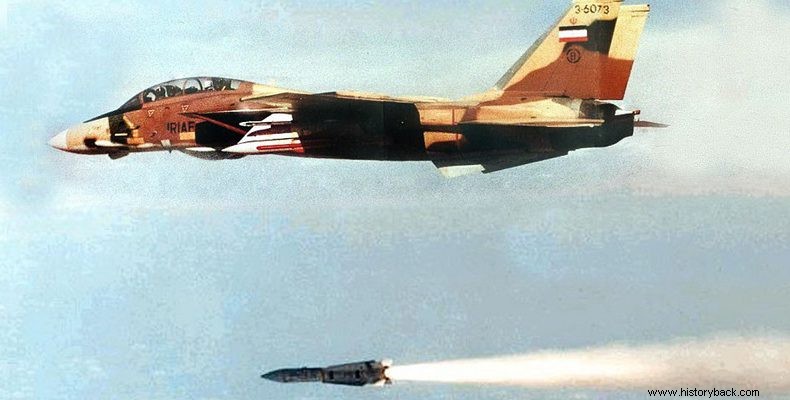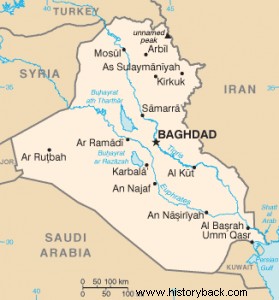
Operation Sultan is one of the most daring air operations carried out by the Iranian Air Force in the Iran-Iraq War. The operation was carried out on October 29, 1980 and targeted the Iraqi al-Huria Air Base in Mosul.
The Iranian air force was informed that 47 French technicians had arrived in Iraq, specifically at the al-Huria base in support of the Mirage F1 fighters which had just bought Iraq, but also to train Iraqi pilots in the press.
Following the information, it was decided to attack the said base with the aim of destroying the Mirages on the ground. The planned operation, however, also had a "punitive" characteras Saddam's air force, unable to defeat its opponent, bombed Iranian cities indiscriminately.
Operation Sultan was planned by Commander Afsar and involved an attack on the base by six Iranian F-4E Phantoms each carrying 12 Mk82 bombs . But the heavily laden aircraft would need aerial refueling to get there and back, so two KC-707 flying tankers were made available for the mission. Two F-14A Tomcats were deployed to protect the tankers.
To avoid Iraqi radars and Iraqi SA-2, SA-3 and SA-6 anti-aircraft missile arrays, Afsar decided the Iranian "package" would fly through Turkish airspace, covered by the Zagros mountains, and then enter Iraq from the north hitting the target. It was a bold decision as nobody knew how the Turks would react.
The "sultan" strikes
The Iranian jets took off before dawn on October 29. In addition to the six F-4s, F-14s and two KC-707s, two more Phantoms, a Tomcat and a KC-707 took off as backups. Commander Afsar led the mission from KC-707 code Sultan 9. The F-4s had Sultan codes 1-6 and the two F-14s Sultan codes 7 and 8.
Iranian reserve aircraft left the formation shortly before it entered Turkish airspace. The Turkish radars detected the Iranian aircraft but the Turkish leadership preferred not to react.
Thus the Iranian "package" arrived over the target without being detected by the Iraqis. Immediately the Phantoms "dive" towards the base while the KC-707s and Tomcats waited higher up.
The raid was executed in an exemplary manner. Two Iraqi MiG-21 fighters and three Mil Mi 8 helicopters were destroyed on the ground and a French technician was killed. The base was badly damaged but no Mirage F1s were spotted.
Aerial combat
At the same time, however, the F-14s, thanks to their excellent AWG-9 radar, detected at a distance of 70 km four Iraqi MiG-23s approaching. Squadronmen Sedgi and Taeyebi flying Sultan 7 and 8 respectively were ordered to engage protecting the unarmed F-4s and especially the flying tankers.
7 had two AIM-54 Phoenix missiles, 3 AIM-7E-4 Sparrow missiles and 2 AIM-9P Sidewinder missiles. 8 had 2 AIM-9P and 6 AIM-7. The Iranian fighters began to gain altitude reaching 15,000 feet and then 22,000 feet without the Soviet-made Iraqi fighters with their inferior radars detecting them.
The weapon systems officer of 7 put the radar in TWS (Track While Scan) mode and tracked all four enemy fighters simultaneously. The radar data was transmitted to the aircraft computer which calculated based on the enemy's speed and altitude , their positions so that they can be hit by AIM-54 missiles.
Indeed 7 launched the first Phoenix and 8 seconds later the second from a distance of 33 km. The Iraqi fighters were flying at a height of 30,000 feet without their pilots having noticed the slightest.
Iranian missiles both found their targets and two MiG-23s were destroyed in the air. The pilots of the other two did not even understand what had hit their colleagues. Scared, however, they made the mistake of "flying high", handing over their only advantage to the opponent.
The Iraqi jets had approached within 12 km and the Iranians decided to attack with AIM-7 missiles. However, due to damage to its electronics, the 8 was unable to shoot. So unable to fight he walked away leaving 7 alone. The Iraqis had lost additional altitude now flying at 10,000 feet.
Squadron Sedgi, turning on the afterburner, gained speed and attacked. Approaching at a distance of 1,500 m, he prepared to launch an AIM-9P missile. But now the Iraqi aircraft had seen him and "broke", both to his right and to his left. The Iranian pilot followed one and launched an AIM-9 which hit the enemy aircraft destroying it.
The other MiG-23, however, was on its tail. Nevertheless, Sedgi performed a sharp climb and then a sharp turn, "loading" the Tomcat to the maximum g's it could handle... Dropping speed dramatically, nose almost vertically down, Sedgi found himself on his opponent's tail and his second AIM-9P hit him.
The Iraqi managed to leave his burning aircraft. Sedgi, with the last drops of fuel, rushed to meet the flying tankers.
Operation Sultan was a complete success for the Iranians. The Iraqis lost all four of their MiG-23s confirming the huge technological gap between their Soviet fighters and the Iranian F-14.

